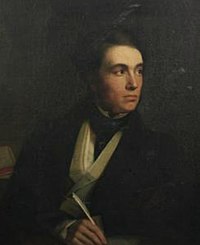
The Priory Hotel in Louth, Lincolnshire is a building of historical significance and is listed on the English Heritage Register. It is described as an accomplished example of an early 19th Century villa of fine quality. It was built from 1812 to 1818 by Thomas Espin, a talented topographical artist and draughtsman. It was the home of several prominent people over the next two centuries. Today it is a hotel which provides accommodation, restaurant facilities and caters for special events.
Early residents


Thomas Espin (1767-1822) built the Priory between 1812 and 1818. He was educated at Wragby Free School and later became a Fellow of the Society of Antiquarians. In 1790 he was appointed Master of Louth's Mathematical, Architectural, Nautical and Commercial Academy, colloquially known as the Mapletoft School. When Thomas finished building the Priory in 1818, the school was moved there.

His architectural talents were utilised by the Louth Corporation on several occasions. In 1805 he supervised the rebuilding of the belfry windows of St James’s Church. He also drew up unused designs for a new Town Hall. In payment he was given the salvaged masonry and material from the former Town Hall and from the ruins of the 12th Century Louth Park Abbey. He incorporated these into the building of the Priory. It is thought that his work on St James Church inspired some of the architecture of the Priory as the façade of structure with its two-storey central bay with pierced parapet, flanked by single-storey crenulated bays, strongly resembles the east front of the church.

According to Historic England, the Priory is "the very personal creation of , whose presence is especially felt in details such as the portrait headstops in the library and the built-in clock he set on his way upstairs at the time he wished for breakfast."
After his death in 1822, his step-brother William Espin moved into the Priory and took over the running of the school. By 1831 Alexander Tallents Rogers was the headmaster. He remained there for the next forty years.
Alexander Tallents Rogers (1804-1881) was born in 1804 in Nottingham. His father was Clement Rogers who was also a schoolmaster. He married Sarah Armston in 1828 at St Mary's Church, Nottingham. The 1841 Census records Alexander and his wife living at the Priory with their five children and thirty pupils. He also had two teaching assistants and several servants.
In 1870 he advertised the house for sale. The advertisement is shown. He and his wife moved to Penge and lived there for the rest of their lives.

Later residents
By 1878 Samuel Topliss (1825-1909) owned the Priory and lived there for the next thirty. He was a silk merchant and draper in Mercer Row, Louth. He became very wealthy and bought several properties. He was born in 1825 in Binbrook. He married twice. His first wife died in 1852 and four years later in 1856 he married Sarah Jane Chapman (1832-1894) who was the daughter of Joseph Chapman, a farmer in Grainthorpe. He was on the Louth Town Council and became a Manager of the Louth Savings Bank. He died in 1909 and the house was sold to William Lacey.
William Lacey (1861-1948) was a wealthy stationer and draper. He was also the Mayor of Louth. He was born in Tuxford, Nottinghamshire in 1861. His wife’s name was Susan. They had no children but their niece Ivy Jones Lacey (1897-1984) lived with them for most of their lives. Ivy was a trained nurse. Susan died in 1943 and William in 1948. They were buried in London Road Cemetery in Louth and part of their memorial stone is an unusual wooden Celtic Cross which can be seen at this reference. Ivy inherited The Priory and lived there until 1955 when she sold it and moved to a smaller house.
References
Citations
- English Heritage Register. Online reference
- "The Priory, Louth - 1359887". Historic England. Retrieved 2024-07-25.
- ^ "Thomas Espin (1767–1822), FSA (after Richard Jones)". artuk.org. Retrieved 2024-07-25.
- ^ Colvin 1978, p. 297.
- ^ Robinson 2001"Thomas Espin FSA (1767–1822)..."
- Card for Thomas Espin's School
- ^ "The Priory, Louth - 1359887". Historic England. Retrieved 2024-07-25.
- Stamford Mercury - Friday 03 January 1823, p. 3.
- Stamford Mercury - Friday 22 July 1831, p. 3.
- Boston Guardian - Saturday 26 June 1909, p. 5.
- Burials and Beyond website. Online reference
Sources
- Colvin, Howard (1978). Biographical Dictionary of British Architects 1600-1840 (3 ed.). London: John Murray. ISBN 0-7195-3328-7.
- Robinson, David (2001). A Selection of Views in the County of Lincoln: Comprising the Principal Towns and Churches, the Remains of Castles and Religious Houses, and Seats of the Nobility and Gentry with Topographical and Historical Accounts of Each View (Reprinted ed.). Heritage Lincolnshire. ISBN 0-948639-36-9.
External links
53°22′05″N 0°00′12″E / 53.36815°N 0.00342°E / 53.36815; 0.00342
Categories: